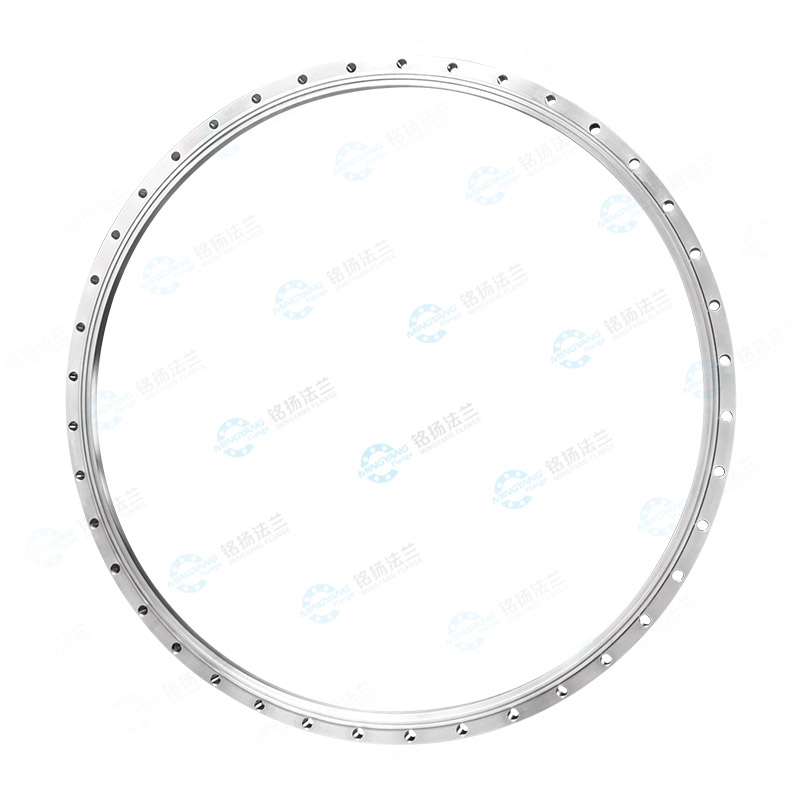News

Large-diameter flanges refer to flange connection components with a relatively large nominal diameter (DN), which are typically used to connect pipes, valves, pumps and other equipment to achieve the transportation, distribution and control of fluids or gases. Its application scenarios are extensive, mainly depending on factors such as the pressure, temperature, medium characteristics of the pipeline system and the installation environment. The following are the typical application scenarios and key considerations of large-diameter flanges:
I. Petroleum and Natural Gas Industry
Long-distance pipelines and gathering and transportation systems
Application scenarios: It is used in long-distance pipelines for transporting media such as crude oil and natural gas (such as the West-East Gas Pipeline Project), and needs to withstand high pressure, low temperature and corrosive media.
Advantages: Large-diameter flanges (such as DN500-DN2000) can be matched with large-diameter pipes, ensuring sealing performance and structural strength, and reducing the risk of leakage.
Material selection: ASTM A105 (carbon steel), A350 LF2 (low-temperature carbon steel) or stainless steel (such as 316L) are often adopted to deal with the corrosiveness of different media.
Refining and chemical plants
Application scenarios: Connecting reactors, heat exchangers, storage tanks and other equipment in oil refineries and ethylene cracking units.
Key requirements: The flange needs to withstand high temperatures (such as above 400°C), high pressures (such as Class 1500), and strongly corrosive media (such as hydrogen sulfide, acids and alkalis).
Special design: It adopts structures such as necked butt-weld flanges (WN) and socket weld flanges (SW), and is combined with metal wound gaskets or octagonal gaskets to achieve reliable sealing.
Ii. Energy and Power Industry
Thermal power and nuclear power systems
Main steam pipeline: Large-diameter flanges (such as DN800-DN1200) are used to connect high-temperature and high-pressure steam pipelines from boilers to steam turbines, and they need to withstand temperatures above 500°C and pressures above 10MPa.
Nuclear-grade requirements: Flanges in nuclear power plants must comply with the ASME BPVC standard and pass non-destructive testing (NDT) and seismic analysis to ensure safety under extreme working conditions.
Wind power and hydropower equipment
Application scenarios: Hydraulic systems of large-scale wind turbine generators, inlet and outlet pipelines of water turbines in hydropower stations.
Design features: The flange needs to be lightweight (such as made of aluminum alloy) and have fatigue resistance to adapt to vibration and alternating loads.
Iii. Chemical Engineering and Pharmaceutical Industry
Transportation of corrosive media
Application scenarios: Pipeline systems for strongly corrosive media such as sulfuric acid, hydrochloric acid, and sodium hydroxide.
Material selection: Hastelloy (such as C-276), Monel (Monel 400) or titanium alloy flanges, combined with PTFE-coated gaskets or flexible graphite gaskets.
Hygiene requirements: The pharmaceutical industry is required to use 316L stainless steel flanges, with a surface roughness Ra≤0.8μm, in compliance with GMP standards.
High-pressure reactors and evaporators
Application scenarios: Inlet and outlet connection of equipment such as polymerization reaction vessels and multi-effect evaporators.
Flange type: Integral flanges (IF) or loose flanges (LJ) are often selected, and high-pressure sealing is achieved by pre-tightening bolts.
Iv. Municipal and Environmental Protection Engineering
Urban water supply and sewage treatment
Application scenarios: Water transmission pipelines and pumping stations in waterworks and sewage treatment plants.
Specification requirements: Large-diameter flanges of DN1000-DN3000, made of ductile iron (QT450) or epoxy resin-coated carbon steel to resist chloride ion corrosion.
Sealing form: Rubber O-ring or ethylene propylene diene monomer (EPDM) gasket, suitable for low-pressure working conditions.
Waste incineration and hazardous waste treatment
Application scenarios: Flue gas pipelines of incinerators, acid-base neutralization reactors.
Temperature and corrosion resistance: The flange must withstand temperatures above 300°C and acidic gases (such as SO₂, HCl), and use C276 Hastelloy or fiberglass reinforced plastic lined flanges.
V. Marine and Ship Engineering
Offshore oil platform
Application scenario: Connection of subsea pipelines (such as Flowline, Riser) to platform equipment.
Anti-corrosion requirements: Use duplex stainless steel (such as 2205) or super duplex steel (2507) flanges, in combination with cathodic protection systems, to resist seawater corrosion.
Impact-resistant design: The flange needs to pass the DNV-GL certification to meet the requirements of offshore wind and wave as well as seismic loads.
LNG carrier
Application scenario: Connection between cryogenic liquid cargo tanks and cargo pumps.
Low-temperature performance: With 9% nickel steel or aluminum alloy flanges and polytetrafluoroethylene (PTFE) gaskets, it maintains sealing performance at a low temperature of -163°C.
Vi. Other special applications
Mining and metallurgical industry
Application scenarios: Pulp conveying pipelines, blast furnace gas recovery systems.
Wear-resistant design: The inner wall of the flange is surfacing with hard alloy (such as Stellite 6), or a ceramic-lined flange is adopted to resist slurry erosion.
Food and dairy processing
Application scenarios: Transportation of media with high hygiene requirements such as milk and fruit juice.
Material standard: 304/316L stainless steel flange, surface polished to mirror finish (Ra≤0.4μm), no dead corners design for easy CIP cleaning.
Vii. Key Parameters for Selecting Large-Diameter Flanges
Nominal diameter (DN) : It is determined based on the outer diameter of the pipe and the flow requirement. Common specifications range from DN500 to DN4000.
Pressure level (Class) : From Class 150 to Class 2500, it needs to match the system design pressure.
Temperature range: Select the material based on the medium temperature (such as -196°C to +600°C).
Sealing surface form:
RF (protruding surface) : Suitable for general working conditions and easy to process.
RTJ (Ring Groove surface) : High pressure, high temperature or hazardous medium.
FF (Full Plane) : Cast iron or fiberglass reinforced plastic flange.
Execution standards: National standard (GB/T 9115), American standard (ASME B16.5), German standard (DIN 2501), etc.
Summary
The application scenarios of large-diameter flanges cover extreme working conditions such as high pressure, high temperature, strong corrosion, low temperature, large flow rate and high hygiene requirements. When selecting the type, the characteristics of the medium, pressure and temperature, installation environment and economy should be comprehensively considered. Products that comply with international standards (such as ASME, DIN) should be given priority, and safety and reliability should be ensured through third-party testing (such as API 6FA fire protection certification).
